tires BMW 328I COUPE 2012 Owner's Manual
[x] Cancel search | Manufacturer: BMW, Model Year: 2012, Model line: 328I COUPE, Model: BMW 328I COUPE 2012Pages: 314, PDF Size: 7.72 MB
Page 249 of 314
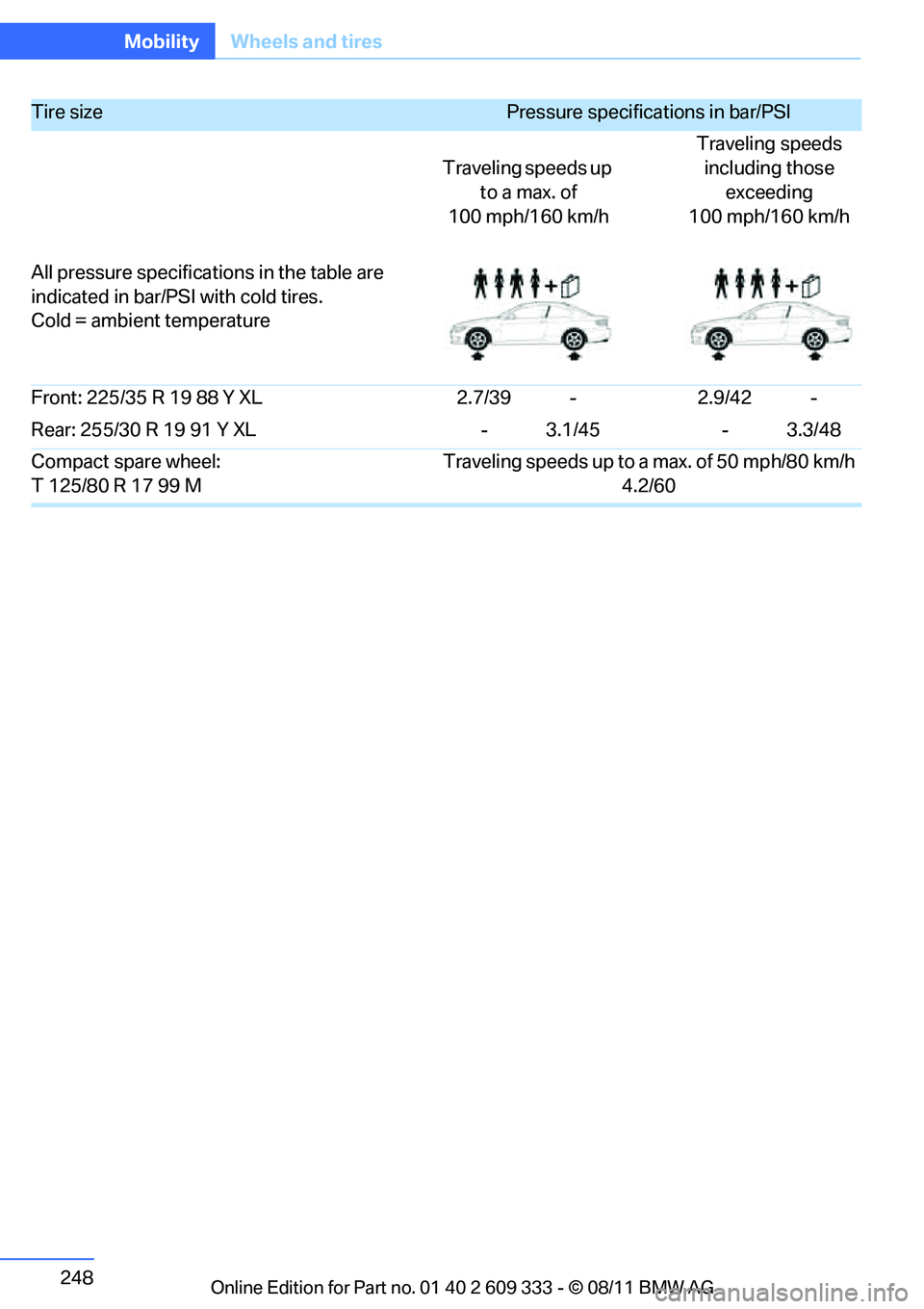
248
MobilityWheels and tires
Front: 225/35 R 19 88 Y XL 2.7/39 -2.9/42 -
Rear: 255/30 R 19 91 Y XL - 3.1/45- 3.3/48
Compact spare wheel:
T 125/80 R 17 99 M Traveling speeds up to a max. of 50 mph/80 km/h
4.2/60
Tire size Pressure specifications in bar/PSI
Traveling speeds up to a max. of
100 mph/160 km/h Traveling speeds
including those exceeding
100 mph/160 km/h
All pressure specificat ions in the table are
indicated in bar/PS I with cold tires.
Cold = ambient temperature
Online Edition for Part no. 01 40 2 609 333 - \251 08/11 BMW AG
Page 250 of 314
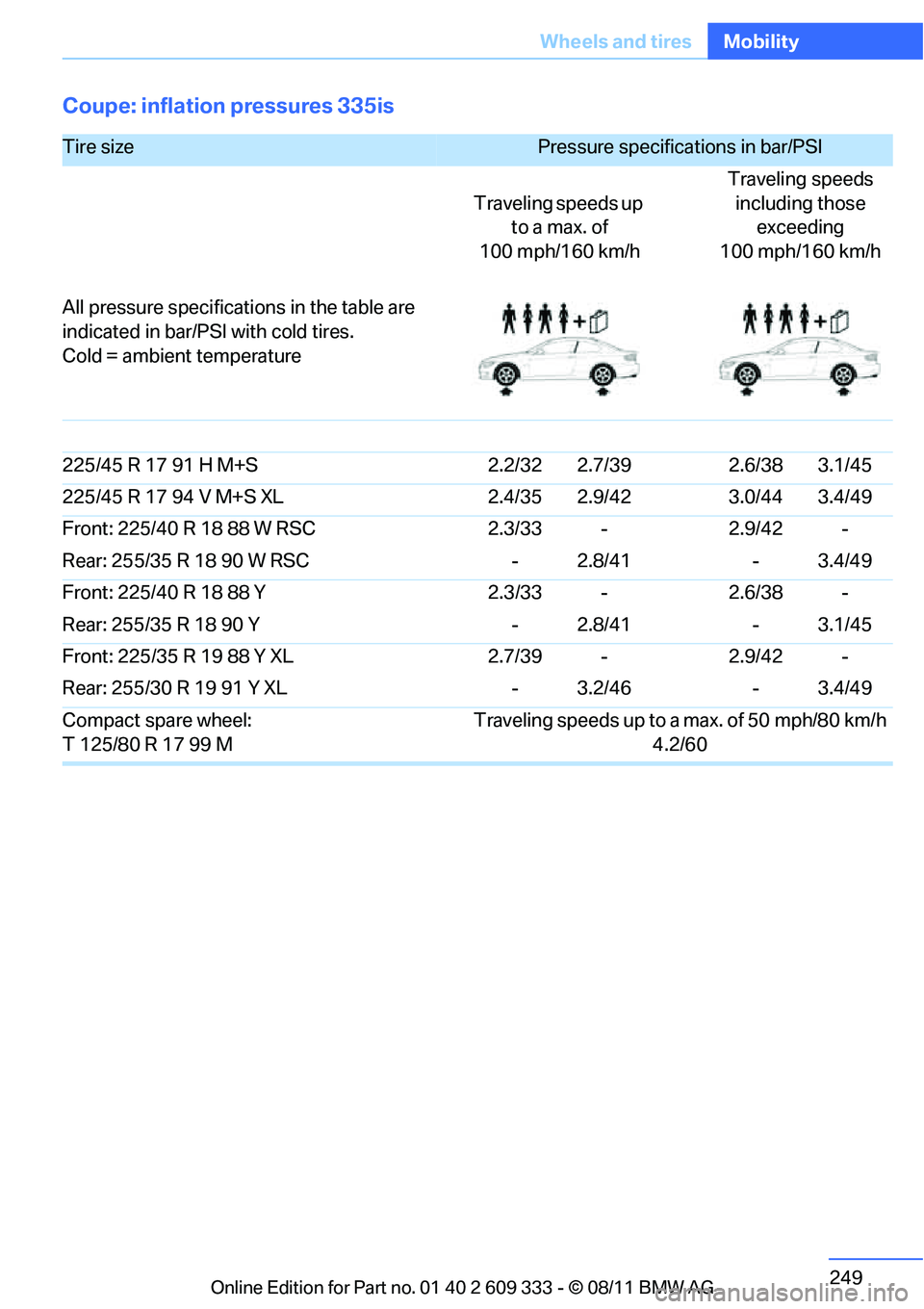
249
Wheels and tires
Mobility
Coupe: inflation pressures 335is
Tire size Pressure specifications in bar/PSI
Traveling speeds up to a max. of
100 mph/160 km/h Traveling speeds
including those exceeding
100 mph/160 km/h
All pressure specifications in the table are
indicated in bar/PSI with cold tires.
Cold = ambient temperature
225/45 R 17 91 H M+S 2.2/32 2.7/39 2.6/38 3.1/45
225/45 R 17 94 V M+S XL 2.4/35 2.9/42 3.0/44 3.4/49
Front: 225/40 R 18 88 W RSC 2.3/33 - 2.9/42 -
Rear: 255/35 R 18 90 W RSC - 2.8/41 - 3.4/49
Front: 225/40 R 18 88 Y 2.3/33 - 2.6/38 -
Rear: 255/35 R 18 90 Y - 2.8/41 - 3.1/45
Front: 225/35 R 19 88 Y XL 2.7/39 - 2.9/42 -
Rear: 255/30 R 19 91 Y XL - 3.2/46 - 3.4/49
Compact spare wheel:
T 125/80 R 17 99 M Traveling speeds up to a max. of 50 mph/80 km/h
4.2/60
Online Edition for Part no. 01 40 2 609 333 - \251 08/11 BMW AG
Page 251 of 314
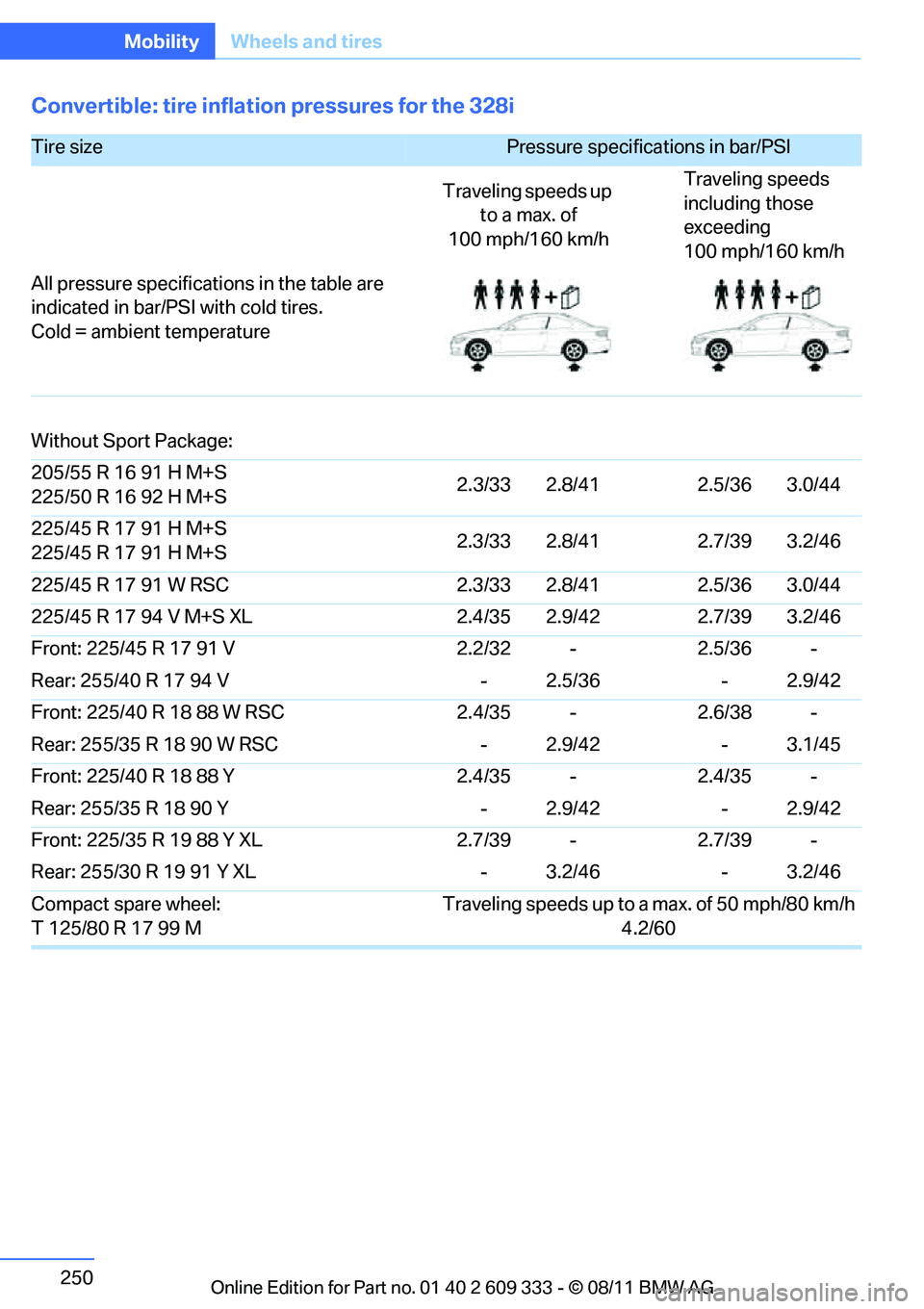
250
MobilityWheels and tires
Convertible: tire inflation pressures for the 328i
Tire size Pressure specifications in bar/PSI
Traveling speeds up to a max. of
100 mph/160 km/h Traveling speeds
including those
exceeding
100 mph/160 km/h
All pressure specificat ions in the table are
indicated in bar/PS I with cold tires.
Cold = ambient temperature
Without Sport Package:
205/55 R 16 91 H M+S
225/50 R 16 92 H M+S 2.3/33 2.8/41
2.5/36 3.0/44
225/45 R 17 91 H M+S
225/45 R 17 91 H M+S 2.3/33 2.8/41
2.7/39 3.2/46
225/45 R 17 91 W RSC 2.3/33 2.8/412.5/36 3.0/44
225/45 R 17 94 V M+S XL 2.4/35 2.9/422.7/39 3.2/46
Front: 225/45 R 17 91 V 2.2/32 -2.5/36 -
Rear: 255/40 R 17 94 V - 2.5/36- 2.9/42
Front: 225/40 R 18 88 W RSC 2.4/35 -2.6/38 -
Rear: 255/35 R 18 90 W RSC - 2.9/42- 3.1/45
Front: 225/40 R 18 88 Y 2.4/35 -2.4/35 -
Rear: 255/35 R 18 90 Y - 2.9/42- 2.9/42
Front: 225/35 R 19 88 Y XL 2.7/39 -2.7/39 -
Rear: 255/30 R 19 91 Y XL - 3.2/46- 3.2/46
Compact spare wheel:
T 125/80 R 17 99 M Traveling speeds up to a max. of 50 mph/80 km/h
4.2/60
Online Edition for Part no. 01 40 2 609 333 - \251 08/11 BMW AG
Page 252 of 314
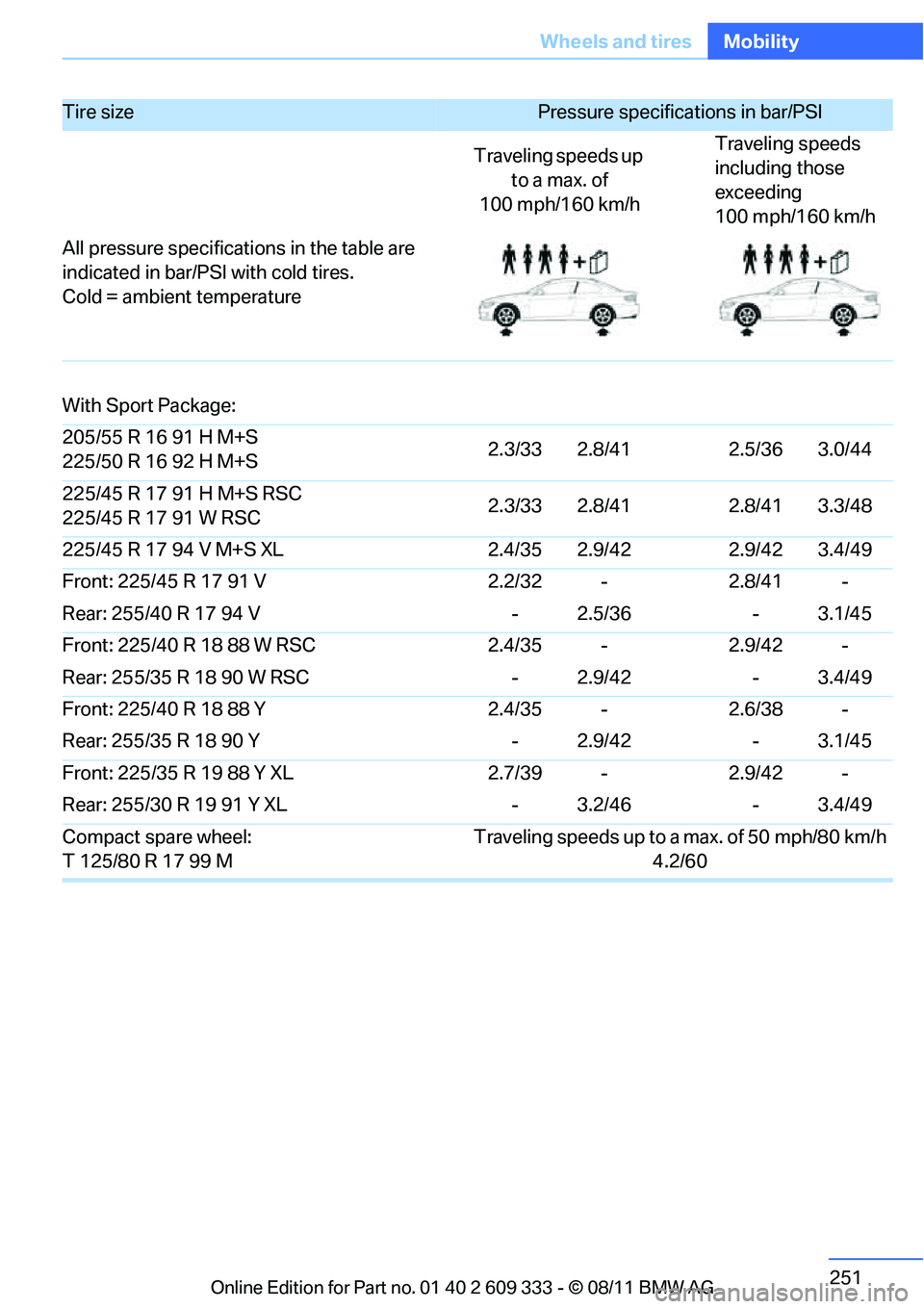
251
Wheels and tires
Mobility
With Sport Package:
205/55 R 16 91 H M+S
225/50 R 16 92 H M+S
2.3/33 2.8/41 2.5/36 3.0/44
225/45 R 17 91 H M+S RSC
225/45 R 17 91 W RSC 2.3/33 2.8/41 2.8/41 3.3/48
225/45 R 17 94 V M+S XL 2.4/35 2.9/42 2.9/42 3.4/49
Front: 225/45 R 17 91 V 2.2/32 - 2.8/41 -
Rear: 255/40 R 17 94 V - 2.5/36 - 3.1/45
Front: 225/40 R 18 88 W RSC 2.4/35 - 2.9/42 -
Rear: 255/35 R 18 90 W RSC - 2.9/42 - 3.4/49
Front: 225/40 R 18 88 Y 2.4/35 - 2.6/38 -
Rear: 255/35 R 18 90 Y - 2.9/42 - 3.1/45
Front: 225/35 R 19 88 Y XL 2.7/39 - 2.9/42 -
Rear: 255/30 R 19 91 Y XL - 3.2/46 - 3.4/49
Compact spare wheel:
T 125/80 R 17 99 M Traveling speeds up to a max. of 50 mph/80 km/h
4.2/60
Tire size Pressure specifications in bar/PSI
Traveling speeds up to a max. of
100 mph/160 km/h Traveling speeds
including those
exceeding
100 mph/160 km/h
All pressure specifications in the table are
indicated in bar/PSI with cold tires.
Cold = ambient temperature
Online Edition for Part no. 01 40 2 609 333 - \251 08/11 BMW AG
Page 253 of 314
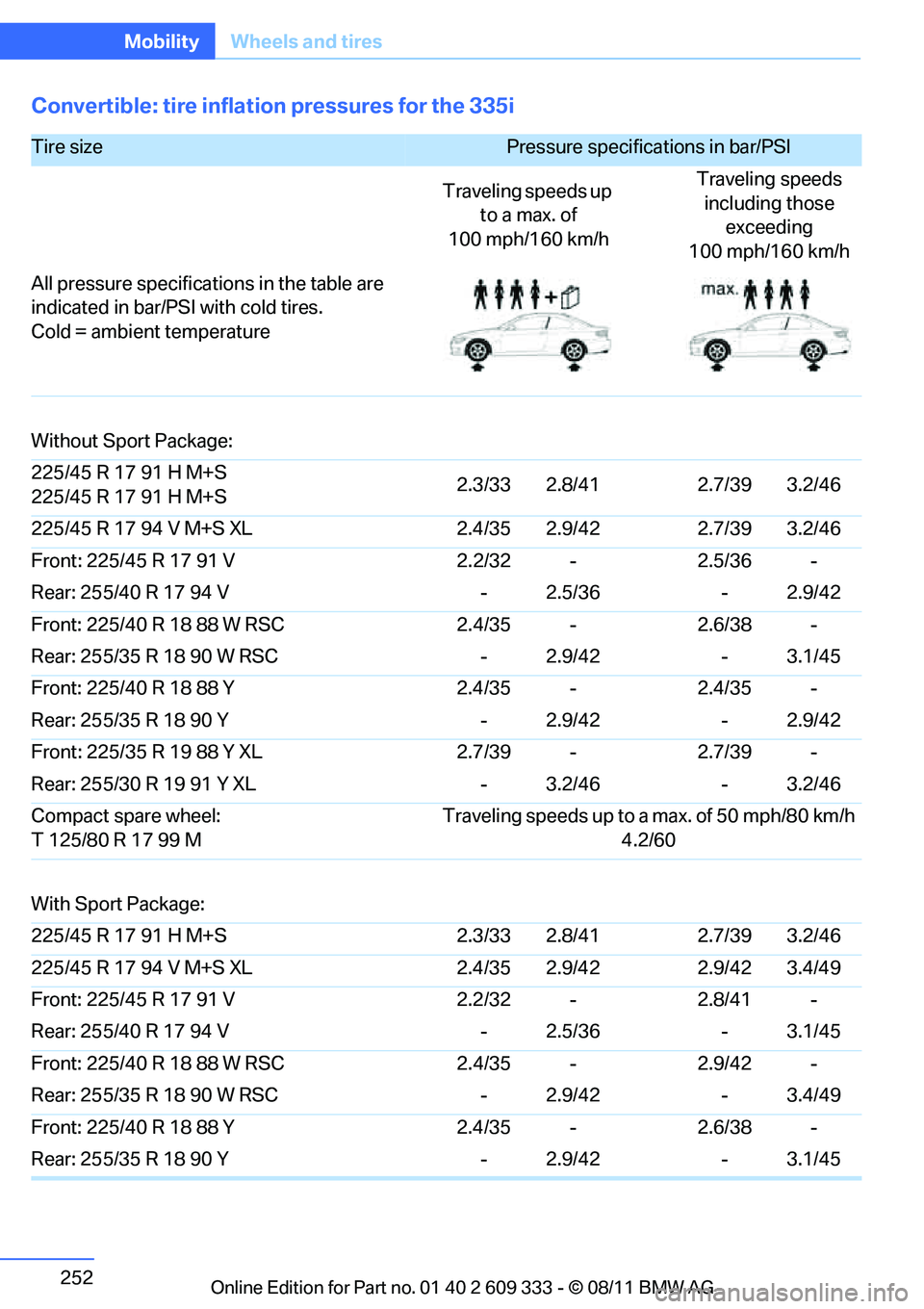
252
MobilityWheels and tires
Convertible: tire inflation pressures for the 335i
Tire size Pressure specifications in bar/PSI
Traveling speeds up to a max. of
100 mph/160 km/h Traveling speeds
including those exceeding
100 mph/160 km/h
All pressure specificat ions in the table are
indicated in bar/PS I with cold tires.
Cold = ambient temperature
Without Sport Package:
225/45 R 17 91 H M+S
225/45 R 17 91 H M+S 2.3/33 2.8/41 2.7/39 3.2/46
225/45 R 17 94 V M+S XL 2.4/35 2.9/42 2.7/39 3.2/46
Front: 225/45 R 17 91 V 2.2/32 - 2.5/36 -
Rear: 255/40 R 17 94 V - 2.5/36 - 2.9/42
Front: 225/40 R 18 88 W RSC 2.4/35 - 2.6/38 -
Rear: 255/35 R 18 90 W RSC - 2.9/42 - 3.1/45
Front: 225/40 R 18 88 Y 2.4/35 - 2.4/35 -
Rear: 255/35 R 18 90 Y - 2.9/42 - 2.9/42
Front: 225/35 R 19 88 Y XL 2.7/39 - 2.7/39 -
Rear: 255/30 R 19 91 Y XL - 3.2/46 - 3.2/46
Compact spare wheel:
T 125/80 R 17 99 M Traveling speeds up to a max. of 50 mph/80 km/h
4.2/60
With Sport Package:
225/45 R 17 91 H M+S 2.3/33 2.8/41 2.7/39 3.2/46
225/45 R 17 94 V M+S XL 2.4/35 2.9/42 2.9/42 3.4/49
Front: 225/45 R 17 91 V 2.2/32 - 2.8/41 -
Rear: 255/40 R 17 94 V - 2.5/36 - 3.1/45
Front: 225/40 R 18 88 W RSC 2.4/35 - 2.9/42 -
Rear: 255/35 R 18 90 W RSC - 2.9/42 - 3.4/49
Front: 225/40 R 18 88 Y 2.4/35 - 2.6/38 -
Rear: 255/35 R 18 90 Y - 2.9/42 - 3.1/45
Online Edition for Part no. 01 40 2 609 333 - \251 08/11 BMW AG
Page 254 of 314
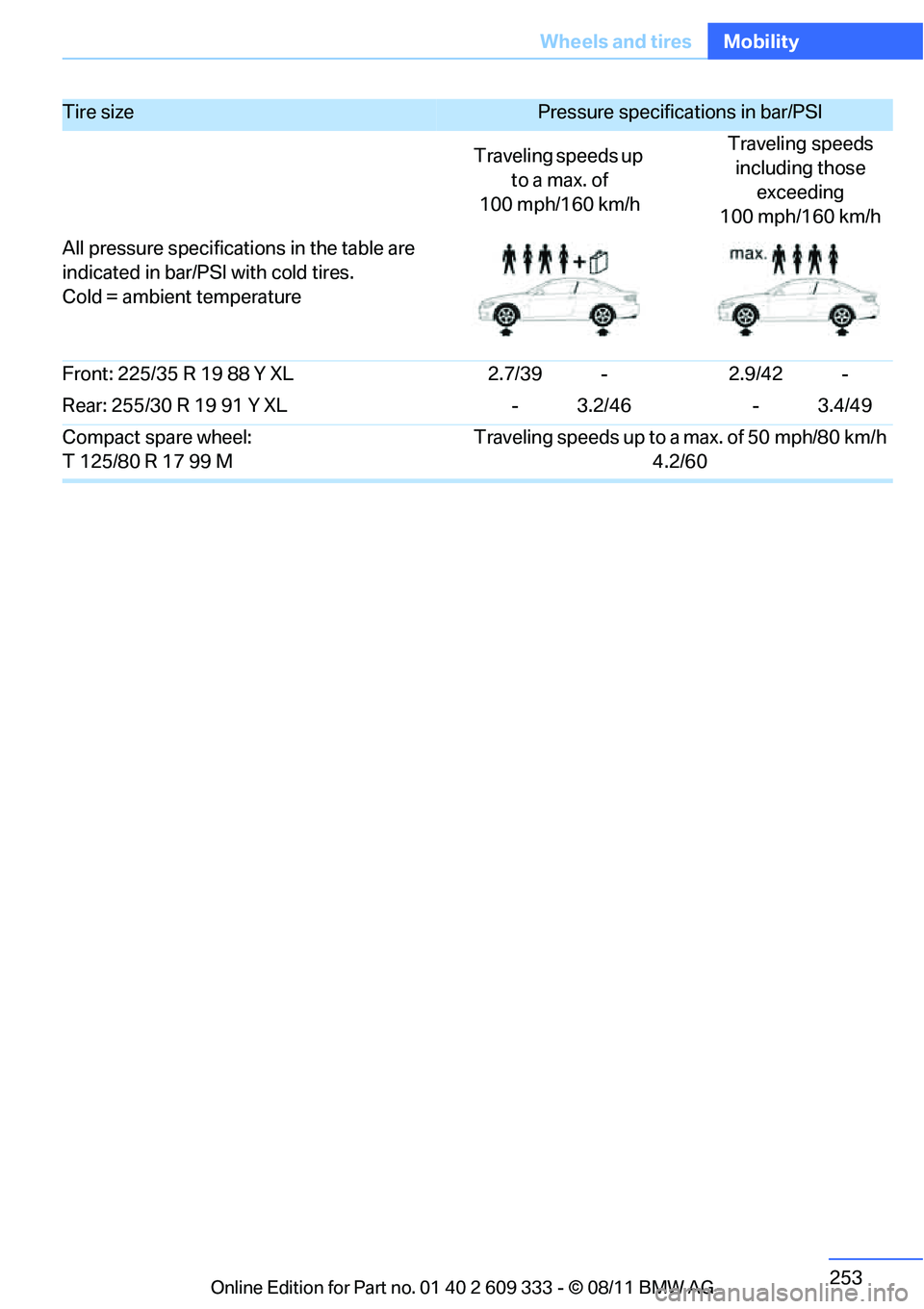
253
Wheels and tires
Mobility
Front: 225/35 R 19 88 Y XL
2.7/39 -2.9/42 -
Rear: 255/30 R 19 91 Y XL - 3.2/46- 3.4/49
Compact spare wheel:
T 125/80 R 17 99 M Traveling speeds up to a max. of 50 mph/80 km/h
4.2/60
Tire size Pressure specifications in bar/PSI
Traveling speeds up to a max. of
100 mph/160 km/h Traveling speeds
including those exceeding
100 mph/160 km/h
All pressure specifications in the table are
indicated in bar/PSI with cold tires.
Cold = ambient temperature
Online Edition for Part no. 01 40 2 609 333 - \251 08/11 BMW AG
Page 255 of 314
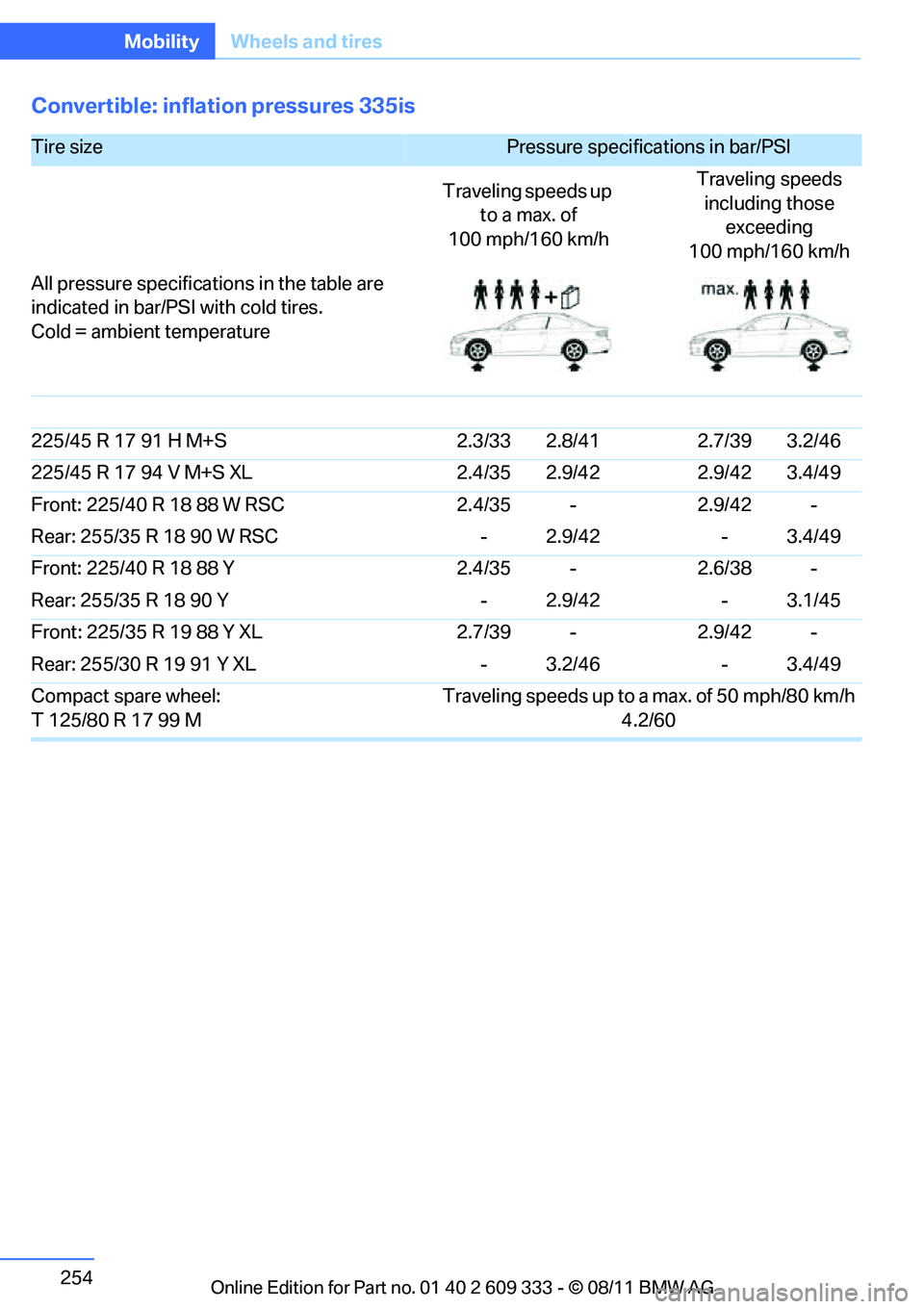
254
MobilityWheels and tires
Convertible: inflation pressures 335is
Tire size Pressure specifications in bar/PSI
Traveling speeds up to a max. of
100 mph/160 km/h Traveling speeds
including those exceeding
100 mph/160 km/h
All pressure specificat ions in the table are
indicated in bar/PS I with cold tires.
Cold = ambient temperature
225/45 R 17 91 H M+S 2.3/33 2.8/41 2.7/39 3.2/46
225/45 R 17 94 V M+S XL 2.4/35 2.9/42 2.9/42 3.4/49
Front: 225/40 R 18 88 W RSC 2.4/35 - 2.9/42 -
Rear: 255/35 R 18 90 W RSC - 2.9/42 - 3.4/49
Front: 225/40 R 18 88 Y 2.4/35 - 2.6/38 -
Rear: 255/35 R 18 90 Y - 2.9/42 - 3.1/45
Front: 225/35 R 19 88 Y XL 2.7/39 - 2.9/42 -
Rear: 255/30 R 19 91 Y XL - 3.2/46 - 3.4/49
Compact spare wheel:
T 125/80 R 17 99 M Traveling speeds up to a max. of 50 mph/80 km/h
4.2/60
Online Edition for Part no. 01 40 2 609 333 - \251 08/11 BMW AG
Page 256 of 314
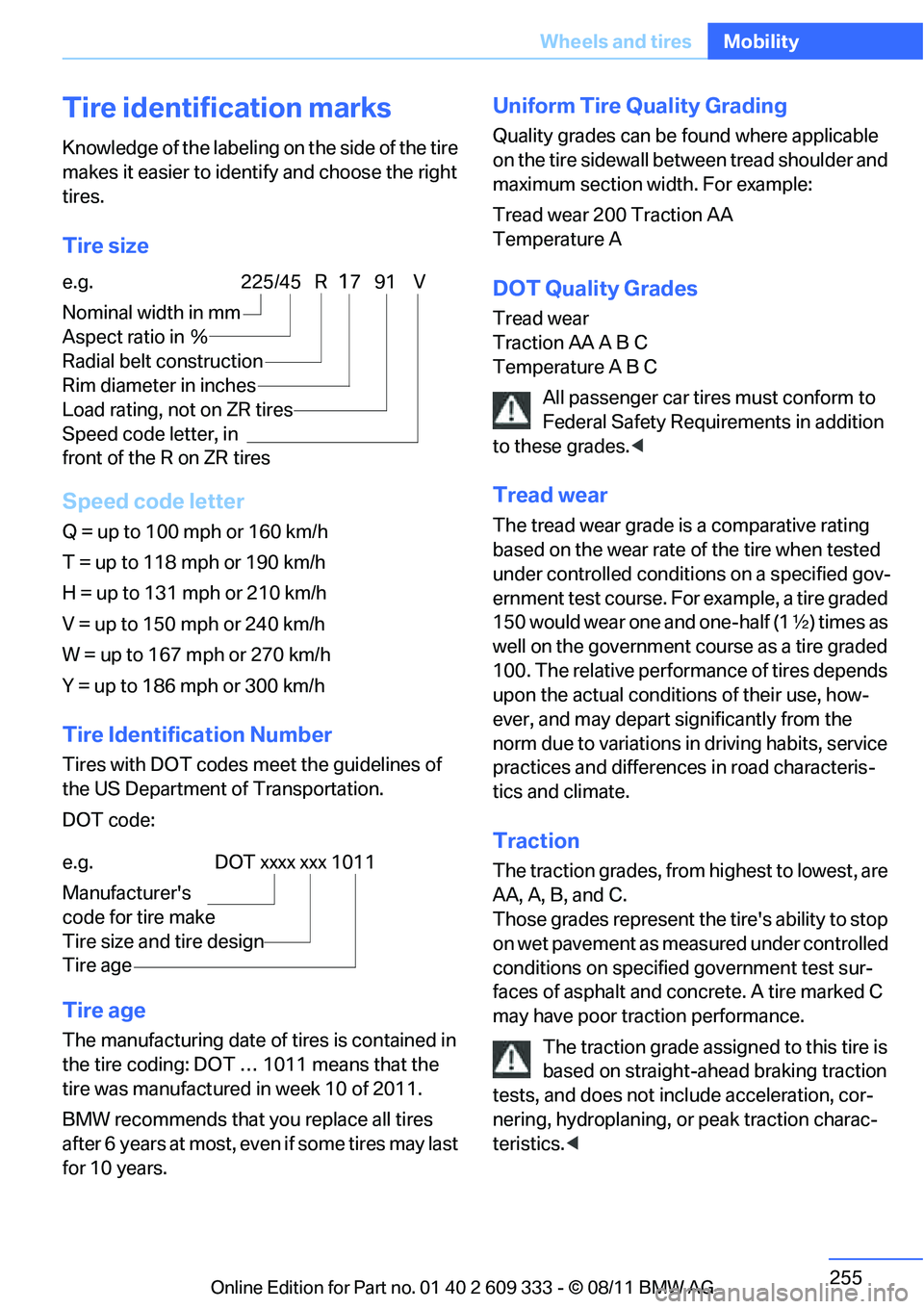
255
Wheels and tires
Mobility
Tire identification marks
Knowledge of the labeling on the side of the tire
makes it easier to identi
fy and choose the right
tires.
Tire size
Speed code letter
Q = up to 100 mph or 160 km/h
T = up to 118 mph or 190 km/h
H = up to 131 mph or 210 km/h
V = up to 150 mph or 240 km/h
W = up to 167 mph or 270 km/h
Y = up to 186 mph or 300 km/h
Tire Identification Number
Tires with DOT codes meet the guidelines of
the US Department of Transportation.
DOT code:
Tire age
The manufacturing date of tires is contained in
the tire coding: DOT … 1011 means that the
tire was manufactured in week 10 of 2011.
BMW recommends that you replace all tires
after 6 years at most, even if some tires may last
for 10 years.
Uniform Tire Quality Grading
Quality grades can be found where applicable
on the tire sidewall between tread shoulder and
maximum section width. For example:
Tread wear 200 Traction AA
Temperature A
DOT Quality Grades
Tread wear
Traction AA A B C
Temperature A B C
All passenger car tires must conform to
Federal Safety Requir ements in addition
to these grades. <
Tread wear
The tread wear grade is a comparative rating
based on the wear rate of the tire when tested
under controlled conditions on a specified gov-
ernment test course. For example, a tire graded
150 would wear one and one-half (1 γ) times as
well on the government course as a tire graded
100. The relative performance of tires depends
upon the actual conditio ns of their use, how-
ever, and may depart significantly from the
norm due to variations in driving habits, service
practices and differences in road characteris-
tics and climate.
Traction
The traction grades, from highest to lowest, are
AA, A, B, and C.
Those grades represent the tire's ability to stop
on wet pavement as measured under controlled
conditions on specifie d government test sur-
faces of asphalt and concrete. A tire marked C
may have poor traction performance.
The traction grade assigned to this tire is
based on straight-ahead braking traction
tests, and does not include acceleration, cor-
nering, hydroplaning, or peak traction charac-
teristics. <
e.g.
Nominal width in mm
Aspect ratio in
Ξ
Radial belt construction
Rim diameter in inches
Load rating, not on ZR tires
Speed code letter, in
front of the R on ZR tires
225/45 R1791 V
e.g.
Manufacturer's
code for tire make
Tire size and tire design
Tire ageDOT xxxx xxx 1011
Online Edition for Part no. 01 40 2 609 333 - \251 08/11 BMW AG
Page 257 of 314
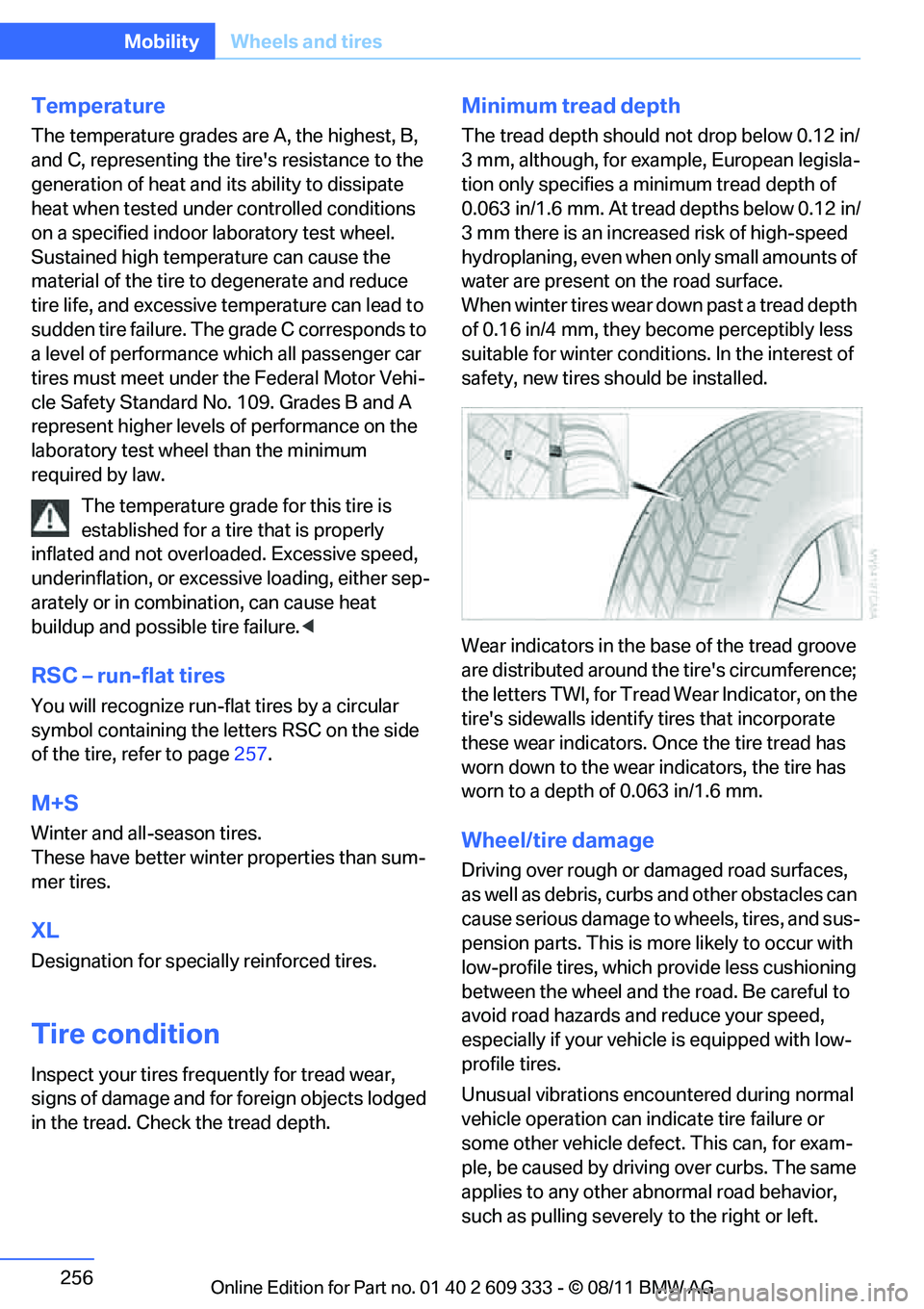
256
MobilityWheels and tires
Temperature
The temperature grades are A, the highest, B,
and C, representing the tire's resistance to the
generation of heat and its ability to dissipate
heat when tested unde r controlled conditions
on a specified indoor laboratory test wheel.
Sustained high temperature can cause the
material of the tire to degenerate and reduce
tire life, and excessive temperature can lead to
sudden tire failure. The grade C corresponds to
a level of performance which all passenger car
tires must meet under the Federal Motor Vehi-
cle Safety Standard No. 109. Grades B and A
represent higher levels of performance on the
laboratory test wheel than the minimum
required by law.
The temperature grade for this tire is
established for a tire that is properly
inflated and not overloaded. Excessive speed,
underinflation, or excessi ve loading, either sep-
arately or in combination, can cause heat
buildup and possible tire failure. <
RSC – run-flat tires
You will recognize run-flat tires by a circular
symbol containing the letters RSC on the side
of the tire, refer to page 257.
M+S
Winter and all-season tires.
These have better winter properties than sum-
mer tires.
XL
Designation for specially reinforced tires.
Tire condition
Inspect your tires frequently for tread wear,
signs of damage and for foreign objects lodged
in the tread. Check the tread depth.
Minimum tread depth
The tread depth should not drop below 0.12 in/
3 mm, although, for exam ple, European legisla-
tion only specifies a minimum tread depth of
0.063 in/1.6 mm. At tread depths below 0.12 in/
3 mm there is an increased risk of high-speed
hydroplaning, even when only small amounts of
water are present on the road surface.
When winter tires wear down past a tread depth
of 0.16 in/4 mm, they become perceptibly less
suitable for winter condit ions. In the interest of
safety, new tires sh ould be installed.
Wear indicators in the ba se of the tread groove
are distributed around th e tire's circumference;
the letters TWI, for Tread Wear Indicator, on the
tire's sidewalls identify tires that incorporate
these wear indicators. Once the tire tread has
worn down to the wear indicators, the tire has
worn to a depth of 0.063 in/1.6 mm.
Wheel/tire damage
Driving over rough or damaged road surfaces,
as well as debris, curbs and other obstacles can
cause serious damage to wheels, tires, and sus-
pension parts. This is more likely to occur with
low-profile tires, which provide less cushioning
between the wheel and th e road. Be careful to
avoid road hazards and reduce your speed,
especially if your vehi cle is equipped with low-
profile tires.
Unusual vibrations encountered during normal
vehicle operation can indi cate tire failure or
some other vehicle defect. This can, for exam-
ple, be caused by driving over curbs. The same
applies to any other abnormal road behavior,
such as pulling severely to the right or left.
Online Edition for Part no. 01 40 2 609 333 - \251 08/11 BMW AG
Page 258 of 314
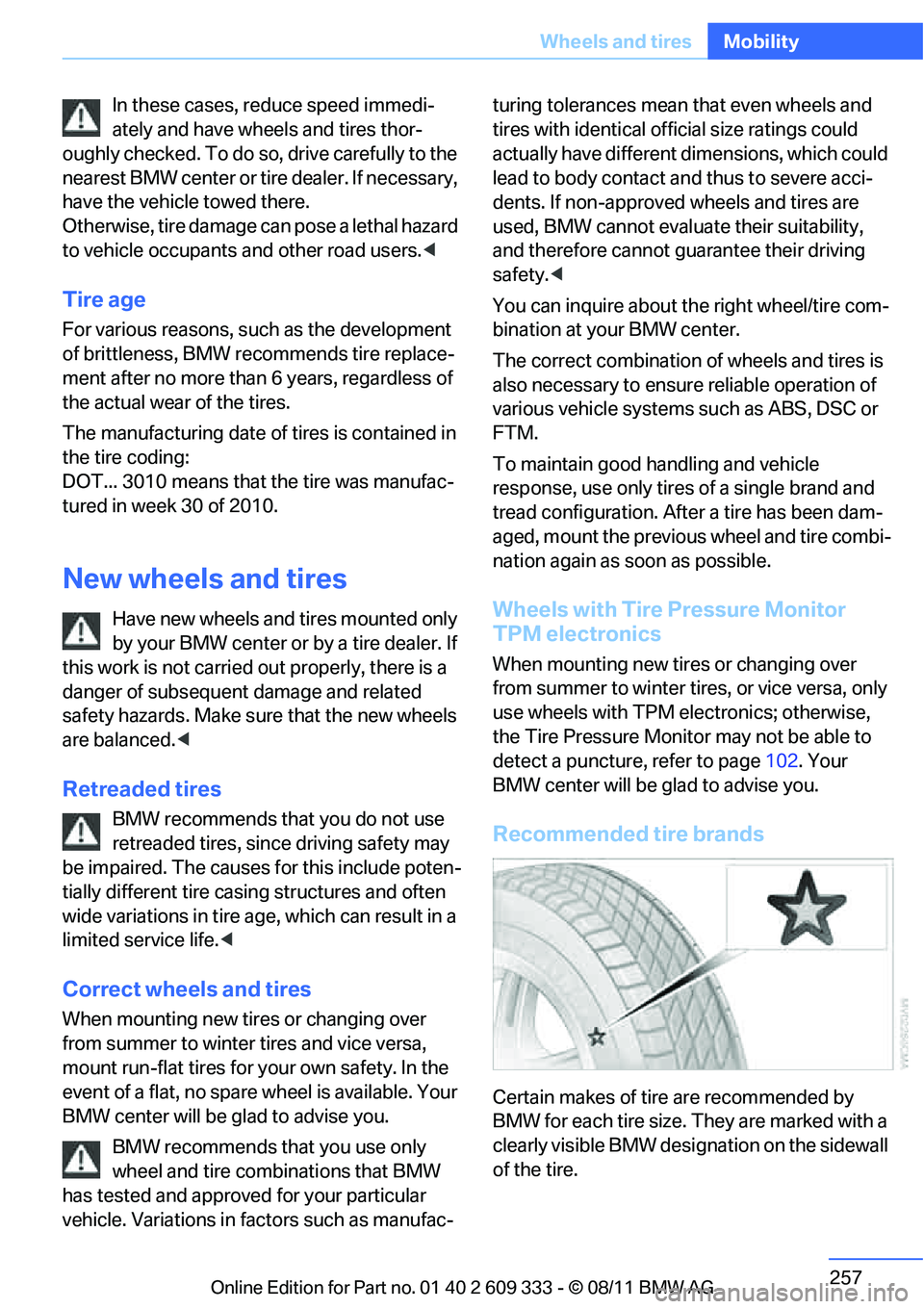
257
Wheels and tires
Mobility
In these cases, reduce speed immedi-
ately and have wheels and tires thor-
oughly checked. To do so , drive carefully to the
nearest BMW center or tire dealer. If necessary,
have the vehicle towed there.
O t h e r w i s e , t i r e d a m a g e c a n pose a lethal hazard
to vehicle occupants and other road users. <
Tire age
For various reasons, such as the development
of brittleness, BMW recommends tire replace-
ment after no more than 6 years, regardless of
the actual wear of the tires.
The manufacturing date of tires is contained in
the tire coding:
DOT... 3010 means that the tire was manufac-
tured in week 30 of 2010.
New wheels and tires
Have new wheels and tires mounted only
by your BMW center or by a tire dealer. If
this work is not carried out properly, there is a
danger of subsequent damage and related
safety hazards. Make sure that the new wheels
are balanced. <
Retreaded tires
BMW recommends that you do not use
retreaded tires, since driving safety may
be impaired. The causes for this include poten-
tially different tire casi ng structures and often
wide variations in tire ag e, which can result in a
limited service life. <
Correct wheels and tires
When mounting new tires or changing over
from summer to winter tires and vice versa,
mount run-flat tires for your own safety. In the
event of a flat, no spare wheel is available. Your
BMW center will be glad to advise you.
BMW recommends that you use only
wheel and tire combinations that BMW
has tested and approved for your particular
vehicle. Variations in factors such as manufac- turing tolerances mean
that even wheels and
tires with identical official size ratings could
actually have different dimensions, which could
lead to body contact an d thus to severe acci-
dents. If non-approved wheels and tires are
used, BMW cannot evaluate their suitability,
and therefore cannot guarantee their driving
safety.<
You can inquire about the right wheel/tire com-
bination at your BMW center.
The correct combination of wheels and tires is
also necessary to ensure reliable operation of
various vehicle systems such as ABS, DSC or
FTM.
To maintain good handling and vehicle
response, use only tires of a single brand and
tread configuration. After a tire has been dam-
aged, mount the previous wheel and tire combi-
nation again as soon as possible.
Wheels with Tire Pressure Monitor
TPM electronics
When mounting new tires or changing over
from summer to winter tires, or vice versa, only
use wheels with TPM electronics; otherwise,
the Tire Pressure Monito r may not be able to
detect a puncture , refer to page102. Your
BMW center will be glad to advise you.
Recommended tire brands
Certain makes of tire are recommended by
BMW for each tire size. They are marked with a
clearly visible BMW designation on the sidewall
of the tire.
Online Edition for Part no. 01 40 2 609 333 - \251 08/11 BMW AG